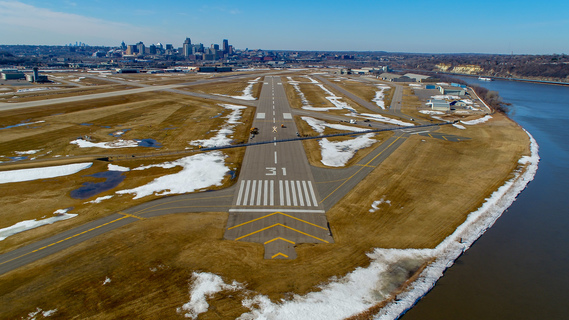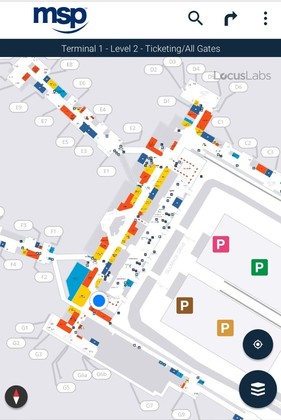|
Maintenance crews deployed the St. Paul Downtown Airport’s floodwall late last week, responding to forecasts that now show the Mississippi River cresting at 20 feet in coming days.
“We’re taking every precaution to stay ahead of the rising waters and keep the airport open and operating safely,” said Joe Harris, manager of the St. Paul Downtown Airport.
Crews from the Metropolitan Airports Commission (MAC) put up the deployable portion of the floodwall in a four-day span starting on Thursday, March 21.
 The deployable floodwall during installation last week at the St. Paul Downtown Airport.
The floodwall shortens runway 14/32, the primary 6,491-foot runway, by about 1,150 feet, but it remains open following the installation.
Two shorter runways at the airport were closed earlier.
Based on the forecasted river crest, the MAC crews’ erected the floodwall to about 75 percent of its maximum height. Additional height could be added later if necessary.
The floodwall allows the airport to remain open, and it's business as usual at the historic terminal building -- including regular hours for Holman’s Table restaurant and bar.
The St. Paul Downtown Airport is an important aviation hub, serving as a base for 90 aircraft. In 2018, the airport handled 40,116 takeoffs and landings.
The full flood protection system at the St. Paul Downtown Airport includes permanent sheet piles and an earthen levy in addition to the removable wall. Together, the total length of the dike’s various sections is 1.8 miles.
Developed in 2008, the deployable section of the floodwall -- which measures 3,200 feet -- maintains airport operations during flood events. This is the sixth time the wall has been deployed.

Dana Nelson, an experienced manager with the Metropolitan Airports Commission (MAC), was recently selected as the organization’s first director of stakeholder engagement.
In this role, Nelson will be responsible for overseeing the Stakeholder Engagement Department, which is charged with connecting the MAC to the community by designing and implementing best-in-class, in-person engagement activities.
The role will require listening to and educating stakeholders and community members about topics such as aircraft noise and facility planning, and designing activities and programs that highlight the benefits of the MAC’s seven-airport system. Nelson will also lead the department in creating and managing key events that promote the MAC brand and have significant organizational reach and impact.
“We created this new leadership role to develop and execute engagement programs that enhance the ways that the MAC connects to the community. With her significant experience in leading engagement programs on a wide variety of aviation and airport issues, Dana brings great expertise to this role. We are excited about the many ways Dana will build and deepen the MAC’s connection to the communities we serve,” said Naomi Pesky, the MAC’s vice president of strategy and stakeholder engagement.
Nelson -- a nine-year MAC employee – was most recently the manager of the MAC’s Noise, Environment and Planning Office. The MAC will fill Nelson’s previous position in the Noise Office, overseeing day-to-day activities related to aircraft noise. In her new role, Nelson will continue to provide overall direction for engaging communities in noise mitigation efforts, ensuring the MAC continues to steward one of the most active and industry-leading aviation noise programs in the nation.
In her prior roles in the Noise Office, Nelson worked closely with FAA air traffic management to communicate the impact of new procedures to surrounding communities. She also developed and implemented outreach strategies for environmental reviews at the Lake Elmo and Crystal Airports.
Notably, Nelson led the efforts of the MAC Noise Office to quantify fuel and carbon emission savings from optimized profile descents (OPDs), which involve aircraft descending at a steady rate on approach rather than frequently accelerating to level off at various altitudes. The project showed that OPDs contribute to a significant reduction in greenhouse gas emissions at MSP. For those efforts, the project received the ACI-NA Environment Achievement Award in 2017.
As a technical advisor to the MSP Noise Oversight Committee, Nelson also worked closely with city staff and elected officials, airline pilots, area business leaders, MAC commissioners and employees, and the FAA.
Nelson started her new position earlier this month.
|

The first games are now less than two weeks away, and MSP is making its final preparations for the crowds expected for the Final Four.
In recent days, the airport has seen a flurry of activity tied to the looming arrival of the NCAA Men's Basketball Tournament, with volunteer training taking place and numerous welcoming graphics going up inside both MSP terminals.
Minneapolis' USBank Stadium is the site of the mens' semifinal games on Saturday, April 6 and the national championship game on Monday, April 8.
|

Pictured: Goldy Gopher, the mascot for the University of Minnesota, made a surprise appearance at one of MSP's Final Four planning meetings last week.
The graphics that are now up include NCAA Tournament brackets in three locations, with regular updates throughout the first weekend's rounds of games, and a steady stream of travelers posing for selfies in front of their favorite team's spot on the bracket.
MSP expects about 47,000 passengers to pass through security checkpoints on Tuesday, April 9, the day after the national championship game.
Additional staff will be positioned in Terminal 1's ticketing lobby to help guide those passengers, and hundreds of volunteers will also be on hand in a coordinated effort to provide Final Four guests with Minnesota hospitality.
|

The recent addition of a new interactive map on MSP Airport's website means you can now navigate to or search for shops, restaurants and amenities at Terminals 1 and 2 to get directions, estimated walk times, and additional information.
“The new mapping program provides travelers with time-saving information about the airport – either from their desktops at home or work before they arrive or on their mobile device while at the airport,” said Eduardo Valencia, chief information officer for the Metropolitan Airports Commission.
On a layover, for instance, travelers can determine how long it will take to get to their next gate after landing, and also see where shops, restaurants and services are along the way.
“Providing an interactive rather than static map also means we can easily keep the information fresh, providing our customers with a better online experience,” said Valencia.
In addition to locations and walk times, the map also provides menus, phone numbers, and descriptions of shops, restaurants or amenities. And, with the key word search function, you can enter a specific food or retail item to identify restaurants or retail stores where you can purchase those items.
To zoom in or out on the map, use the + and - buttons on a desktop, or pinch-and-zoom on a mobile touch screen. Zooming all the way out allows you to see the entire airport campus, including both terminals, the location of the parking ramps, and surrounding roadways.
Planning to travel soon? Check out the new interactive map to help you expertly navigate MSP.
|
Board Meetings
Business Opportunities
Career Opportunities
General Aviation Airport Information
InterContinental Hotel
MSP Aircraft Noise Information
MSP Airport
|